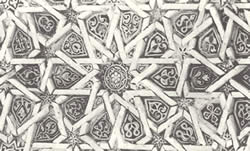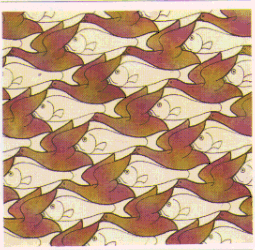Tesselations
The learning target for this lesson is learning what a regular tesselation is, and learning how to create one.
Here is an example:

On this example, the tesselation farthest to the left uses ONLY REGULAR triangles. Because it uses only REGULAR triangles, it is a REGULAR tesselation. If it had more than 1 type of REGULAR shape, it would be a semi-regular tesselation. If it didn't use REGULAR shapes, it would be a tesselation (not a REGULAR tesselation!). The following picture has a tesselation (not a REGULAR tesselation!)

Here is a quote from the artist of the following tesselation pictures, M.C. Escher.
The geometry of space translates to a reoccurring theme in my creations: the tessellation. A tessellation is an arrangement of closed shapes that completely covers the plane without overlapping and without leaving gaps. The regular division of the plane had been considered solely in theory prior to me, some say. I diverged from traditional approaches, and chose instead to find solutions visually. Where other mathematicians used notebooks, I preferred to use a canvas.
To gain access to a greater number of designs, I used transformational geometry techniques including reflections, glide reflections, translations, and rotations. The result is a ´mathematical tessellation of artistic proportions.
See some fish tesselate!
See somebody elses' blog on tesselations!
Comments: 1
Spectacular! I love the quote from Escher. It's interesting to read that he used the same terms we are learning in class. I also like how you linked to another student's blog. I'm interested to see what your final project looks like.
Mr. Tubbs

